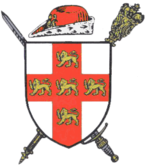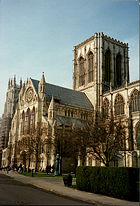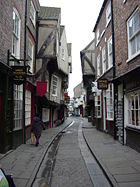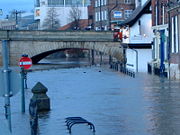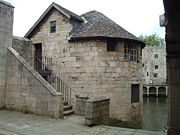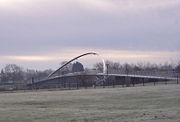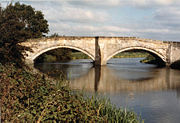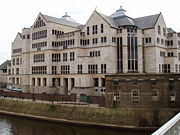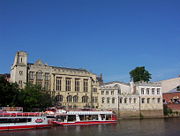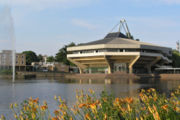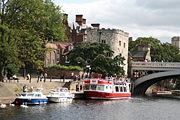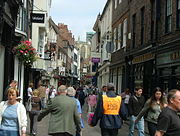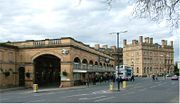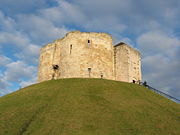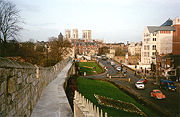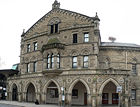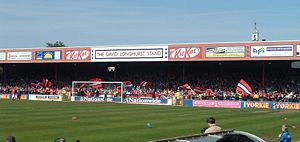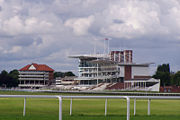York
2008/9 Schools Wikipedia Selection. Related subjects: British Cities; Great Britain
| City of York | |||
| View of York Minster from the city walls. | |||
|
|||
| York shown within England | |||
| Coordinates: | |||
|---|---|---|---|
| Sovereign state | United Kingdom | ||
| Constituent country | England | ||
| Region | Yorkshire and the Humber | ||
| Ceremonial county | North Yorkshire | ||
| Admin HQ | York City Centre | ||
| Settled by Romans | as Eboracum c. AD 71 | ||
| Government | |||
| - Type | Unitary Authority, City | ||
| - Governing body | City of York Council | ||
| - Leadership: | Leader and Executive | ||
| - Executive: | Liberal Democrat | ||
| - MPs: | Hugh Bayley (L) John Greenway (C) John Grogan (L) Anne McIntosh (C) |
||
| Area | |||
| - Total | 105 sq mi (271.94 km²) | ||
| Population (2005 est / Urban 2006) | |||
| - Total | 191,800 ( Ranked 74th) | ||
| - Density | 1,779.3/sq mi (687/km²) | ||
| - Ethnicity ( 2001 Census) |
97.8% White | ||
| Time zone | Greenwich Mean Time ( UTC+0) | ||
| - Summer ( DST) | British Summer Time ( UTC+1) | ||
| Postcode | YO | ||
| Area code(s) | 01904 | ||
| ISO 3166-2 | GB-YOR | ||
| ONS code | 00FF | ||
| OS grid reference | SE603517 | ||
| NUTS 3 | UKE21 | ||
| Website: www.york.gov.uk | |||
York ( pronunciation ) is a historic walled city in North Yorkshire, England, at the confluence of the rivers Ouse and Foss. The city is noted for its rich history, playing an important role throughout much of its existence; it is nearly 2,000 years old.
The city was founded as Eboracum in AD 71 by the Romans and was made one of the two capitals of all Roman Britain. During this period influential historical figures, such as Constantine the Great, became associated with the city. The entire Roman Empire was governed from York for two years by Septimus Severus.
After the Angles moved in, the city was renamed Eoferwic, and served as the capital of the Kingdom of Northumbria. The Vikings captured the city in 866, renaming it Jórvík, the capital of a wider kingdom of the same name covering much of Northern England. Around the year 1000, the city became known as York.
Richard II wished to make York the capital of England, but before he could effect this he was deposed. After the Wars of the Roses, York housed the Council of the North and was regarded as the capital of the North. It was only during the 1660s that the political importance of the city began to decline. Nevertheless, York was the county town of Yorkshire, to which it lent its name. The Province of York is one of the two English ecclesiastical provinces, alongside that of Canterbury.
From 1996, the term City of York describes a unitary authority area which includes rural areas beyond the old city boundaries. The urban area has a population of 137,505, while the entire unitary authority has 184,900 people. Currently, the core of the city within the walls is a major tourist destination, attracting visitors from all over the world.
Etymology
The name 'York' ultimately derives from the Latin name for the city, variously rendered as Eboracum, Eburacum or Eburaci. The first known recorded mention of York by this name is dated circa 95-104 AD and is an address on a wooden stylus tablet from the Roman fortress of Vindolanda in Northumbria.
The etymology of Eboracum is uncertain as the language of the indigenous population of the area was never recorded. One theory is that Eboracum is derived from the Proto-Brythonic word Eborakon which can mean "place of the yew trees" or "the field of Eburos". Efrog in Welsh, Eabhrac in Irish Gaelic, Iorc in Scottish Gaelic.The name is then thought to have been Latinized by replacing -akon with -acum. Another theory is that the language of the indigenous population was a Germanic language similar to Old English and so Eboracum is derived from *eburaz meaning a boar.
The Anglo-Saxons who inhabited York in the 7th century knew it as Eoferwic. Two centuries later, as a Viking trading centre, the city was known as Jórvík.
This was reduced to York in the centuries after the Norman Conquest, moving from the Middle English Yerk to Yourke in the 14th century through to Yourke in the 16th and then Yarke in the 17th century. The form York is first found in the 13th Century.
History
There is archaeological evidence that Mesolithic people settled in the region where York now is from 8000/7000 BC, although it is not known if these were permanent or temporary settlements. By the time of the Roman conquest of Britain, the area was occupied by tribes known to the Romans as the Brigantes. The Brigantes initially became a Roman client state but later became more hostile to Rome. As a result the Roman Ninth Legion was sent north of the Humber.
The city itself was founded in AD 71, when the Ninth Legion conquered the Brigantes and constructed a military fortress (castra) on flat ground above the River Ouse near its junction with the River Foss. The fortess was later rebuilt in stone, covered an area of 50 acres, and was inhabited by 6,000 soldiers. Much of the Roman fortress now lies under the foundations of York Minster, and excavations in the Minster's undercroft have revealed some of the original walls.
The Emperors Hadrian, Septimius Severus and Constantius I all held court in York during their various campaigns. During his stay, the Emperor Severus proclaimed York capital of the province of Britannia Inferior, and it is likely that it was he who granted York the privileges of a colonia or city. Constantius I died during his stay in York, and his son Constantine the Great was proclaimed Emperor by the troops based in the fortress.
In the seventh century York became the chief city of the Angle King Edwin of Northumbria. The first Minster church was built at this time, for the baptism of Edwin in 627. Edwin ordered that this small wooden church should be rebuilt in stone, but he was killed in 633 and the task of completing the stone Minster fell to his successor Oswald.
In 866, Northumbria was in the midst of civil war when the Vikings raided and captured York. Under Viking rule the city became a major river port, part of the extensive Viking trading routes throughout northern Europe. The last ruler of an independent Jorvik, Eric Bloodaxe, was driven from the city in the year 965 by King Edred, completing the unification of England.
In 1069, York was ravaged by William the Conqueror as part of the harrying of the North. The old ancient Minster was badly damaged by fire at this time, and the Normans took the decision to build a new Minster on a fresh site. Around the year 1080 Archbishop Thomas started building a cathedral that in time became the current Minster. York started to prosper again, becoming a profitable port and centre of trade, particularly in wool. King Henry I granted the city's first charter, confirming trading rights in England and Europe.
In 1190, York was the site of an infamous pogrom of its Jewish inhabitants. The Jews sought sanctuary in Cliffords Tower, one of the city's fortifications. The mob besieged the trapped Jews for some days while preparations were made to storm the castle. Eventually a fire was started, whether by the Jews or their persecutors is uncertain, and 150 Jews lost their lives.
The city underwent a period of decline during Tudor times. Under Henry VIII, the dissolution of the monasteries saw the end of the monastic houses of York, most Northerners were Catholics and were upset with this, leading to the Pilgrimage of Grace in York. Henry VIII eventually reinstated the Council of the North in York, and this increased in importance under Elizabeth I, leading to a revival in the city's influence.
In 1644, during the Civil War, the Parliamentarians besieged York, but with the arrival of Prince Rupert, with an army of 15,000 men, the siege was lifted. The Parliamentarians retreated some six miles from York with Rupert in pursuit, before turning on his army and devastatingly defeating it at the Battle of Marston Moor. Of Rupert's 15,000 troops, no fewer than 4,000 were killed and 1,500 captured. The siege was renewed, but the city could not hold out for long, and on July 15 the city surrendered to Sir Thomas Fairfax.
Following the restoration of the monarchy in 1660, and the removal of the garrison from York in 1688, the city was gradually dominated by the local aristocracy and gentry. Competition from the nearby cities of Leeds and Hull resulted in York losing its preeminent position as a trading centre, but the city's role as the social and cultural centre for wealthy northerners was on the rise. York's many elegant townhouses date from this period, as do the Assembly Rooms, the Theatre Royal, and the Racecourse.
George Hudson was responsible for bringing the railway to York in 1839. Although Hudson's career as a railway entrepreneur eventually ended in disgrace, by this time York was a major railway centre. By the turn of the century the railway accommodated the headquarters and works of the North Eastern Railway, which employed over 5,500 people in York. The railway was also instrumental in the expansion of Rowntree's Cocoa Works and Terry's Confectionery Works, who were major employers in the city.
With the emergence of tourism as a major industry, the historic core of York became one of the city's major asset, and in 1968 it was designated a conservation area. The existing tourist attractions were supplemented by the establishment of the National Railway Museum in York in 1975. The opening of the University of York in 1963 added to the prosperity of the city. The fast and frequent railway service, which brings York within two hours journey time of London, has resulted in a number of companies opening offices in the city.
Geography
Location
York lies within the Vale of York, a flat area of arable land bordered by the Pennines, North York Moors and Wolds, at the confluence of the Rivers Ouse and Foss on a terminal moraine left by the last Ice Age.
During Roman times, the land surrounding the rivers Ouse and Foss was very marshy, making it easier to defend. The city is prone to flooding from the River Ouse, and has an extensive (and mostly effective) network of flood defences. These include walls along the Ouse, and a liftable barrier across the River Foss where it joins the Ouse. In October and November 2000 York experienced the worst flooding in 375 years with over 300 homes being flooded. Much land in and around the city has always been too flood-prone for development.
Demographics
At the time of the 2001 UK census the population of York was 181,094 and its ethnic composition was 97.84% White, compared with the English average of 90.92%. In terms of class, York is also less diverse than most cities; there are not many areas of York can be categorised as working- or middle-class areas in the way that most areas of Leeds could be. York's population has a slightly higher elderly population than the national average.
City areas and surrounding villages
- Acaster Malbis, Acomb, Askham Bryan, Askham Richard
- Bishopthorpe, Bootham
- Cawood, Clifton, Copmanthorpe, Crockey Hill
- Deighton
- Derwenthorpe (new village, planning permission granted)
- Dringhouses
- Dunnington
- Earswick, Elvington
- Escrick
- Fishergate, Fulford
- The Groves
- Haxby, Heslington, Hessay, Heworth, Holgate, Holtby, Huntington
- Kexby, Knapton
- Layerthorpe
- Middlethorpe, Moor End, Murton
- Naburn, Nether Poppleton, New Earswick
- Osbaldwick
- Rawcliffe, Rufforth
- Skelton, South Bank, Stockton-on-the-Forest, Strensall, Stamford Bridge
- Tang Hall, Towthorpe
- Upper Poppleton
- West Huntington, Wheldrake, Wigginton, Woodthorpe
The ings are flood meadows along the River Ouse, while the strays are scattered around the city in marshy, low-lying places.
Economy
York's economy is based on the service industry with 87.1% in 2006 of employment in the city is area The service industries in York include public sector employment, health, education, finance, IT and tourism that accounts for 10.9% of employment. Unemployment in York is low at 1.9% in 2007 compared to the United Kingdom national average of 3%. The three biggest employers in York are the City of York Council with over 6,500 employees, Norwich Union Life and North Yorkshire and York Primary Care Trust both with between 3000 and 5000 employees. Other major employers include Card Protection Plan, Nestlé, Shepherd Building Group and British Telecom as well are a number of different railway companies.
This is very different from the position of the economy as recently as the 1950s, when York's prosperity was based on chocolate manufacturing and the railways this position continued until the early 1980s when 30% of the workforce were employed by just five employers and 75% of manufacturing jobs were in four companies. Most of the industry around the railway has gone, including the carriage works (known as ABB at the time of closure) which at its height in 1880s employed 5,500 people but closed in the mid 1990s. York is the headquarters of the confectionery manufacturer Nestlé Rowntree, and home to the KitKat, Smarties (though not for much longer) and eponymous Yorkie bar chocolate brands. Terry's chocolate factory, makers of the Chocolate Orange, was also located in the city; but it closed on 30 September 2005, when production was moved by its owners, Kraft Foods, to Poland. However, the historic factory building can still be seen, situated next to the Knavesmire racecourse.
It was announced on the 20 September 2006 that Nestlé would be cutting 645 jobs at the Rowntree's chocolate factory in York. This came after a number of other job losses in the city at Norwich Union, British Sugar and Terry's chocolate factory. Despite this, the employment situation in York remains fairly buoyant, with at least one major employer (NU) still employing more people in the city than it did five years ago.. Since the closure the site has been developed into the headquarters for CPP and two housing schemes, one of which was a Self-build project. York's economy has been developing in the areas of science, technology and the creative industries with the creation of a science park near University of York and the city becoming a founding National Science City. Between 1998 and 2008 York has gained 80 new technology companies and 2,800 new jobs in the sector.
Regional gross value figures added for York, at current basic prices in pounds sterling, are:
| Year | Agriculture | Industry | Services | Total |
|---|---|---|---|---|
| 1995 | 30 | 579 | 1,443 | 2,052 |
| 2000 | 13 | 782 | 2,168 | 2,963 |
| 2003 | 16 | 779 | 2,505 | 3,299 |
Governance
Local government
York is the traditional county town of Yorkshire, to which it lends its name. Because of this, it did not form part of any of the three historic ridings, or divisions, of Yorkshire.
York is an ancient borough, and was one of the boroughs reformed by the Municipal Corporations Act 1835 to form a municipal borough. It gained the status of a county borough in 1889, under the Local Government Act 1888, and existed so until 1974, when, under the Local Government Act 1972, it became a non-metropolitan district in the county of North Yorkshire.
In the 1990s UK local government reform, York became one of the many boroughs to regain unitary status, but was the only one to see a substantial alteration in its borders, taking in parts of Selby and Harrogate districts, and about half the population of Ryedale district. Unsurprisingly, this caused tension with its neighbours. Ironically, the new boundary had not been promoted by the council, which had proposed the area contained within the A64/ A1237 ring road. The current boundary was imposed after central Government had rejected the council's proposal.
The City of York Council has 47 councillors. As a result of the 2007 local elections (and a By-election in September 2007), no party has an absolute majority, resulting in no overall control. The Liberal Democrats have 20 councillors and in May 2007 they formed a minority administration, and an executive of nine councillors, to lead the Council for the next 12 months. The Labour Party formed the Opposition with 18 councillors. The Conservative Party has seven councillors and the Greens have 2.
In 2007, Councillor Irene Waudby was appointed York’s Lord Mayor and Councillor Keith Hyman York’s Sheriff with both appointments lasting a year. Although York’s Sheriff office is the oldest in England it is now a purely ceremonial post. The Lord Mayor also carries out civic and ceremonial duties in addition to chairing full meetings of the Council.
National government
Most of York is covered by the City of York constituency of the Parliament of the United Kingdom, though the outer parts of the city and local authority area presently fall within the Selby, Vale of York and Ryedale constituencies.
The whole of the city and local authority area lies within the Yorkshire and the Humber constituency of the European Parliament.
Law courts
The city has its own Magistrates' Court, and more unusually also a Crown Court and County Court. It is served by the North Yorkshire Police Service.
Twin cities
York is twinned with:
Education
The University of York is on the outer edge of the city at Heslington. It was York's only institution with university status until 2006, when the centrally located York St John University College, formerly an autonomous college of University of Leeds, attained full university status as York St John University. The city also hosts a branch of the College of Law.
The University of York also boasts one of the most highly rated medical schools, Hull York Medical School.
The city has two major further education institutions. York College is an amalgamation of York Technical College and York Sixth Form College. Students there study a very wide range of academic and vocational courses, and range from school leavers and sixth formers to people training to make career moves. Askham Bryan College offers further education courses, foundation and honours degrees, specialising in more vocational subjects such as Horticulture, Agriculture, Animal Management and even Golf Course Management.
There are over 55 schools in the City of York area. The Local Education Authority is the City of York Council, who manage most primary and secondary schools within the city. About 40 primary schools cover education from ages 5-11, with some offering early years education from age three. From 11-16 education is then provided by 11 secondary schools, four of which offer additional education up to age 18.
York also has several private schools. St Peter's School is famous as the school attended by Guy Fawkes. Two others have Quaker origins: Bootham School is co-educational and The Mount School is all-girls. On the outskirts of the city is Queen Margaret's School.One other is The Minster School.
On September 10th 2007 Oaklands Sports College and Lowfield Comprehensive school merged to become one school. The new school is known as York High School, and the headteacher is David Ellis, who was previously headteacher at Oaklands. In January 2009 the school hopes to move back to the Oaklands site on Cornlands Road.
Transport
York's location on the River Ouse and in the centre of the Vale of York means that it has always had a significant position in the nation's transport system.
River transport
The city grew up as a river port at the confluence of the River Ouse and the River Foss. The Ouse was originally a tidal river, accessible to sea-going ships of the time. Today both of these rivers remain navigable, although the Foss is only navigable for a short distance above the confluence. A lock at Naburn on the Ouse to the south of York means that the river in York is no longer tidal.
Until the end of the 20th century, the Ouse was used by barges to carry freight between York and the port of Hull. The last significant traffic was the supply of newsprint to the local newspaper's Foss-side print works, which continued until 1997. Today navigation is almost exclusively leisure-oriented. YorkBoat provides cruises on the river.
Road transport
Like most cities founded by the Romans, York is well served by long distance trunk roads. The city lies at the intersection of the A19 road from Doncaster to Tyneside, the A59 road from Liverpool to York, the A64 road from Leeds to Scarborough, and the A1079 road from York to Hull. The A64 road also provides the principal link to the motorway network, linking York to both the A1(M) and the M1 motorways at a distance of about 10 miles from the city.
The city is surrounded on all sides by an outer ring road, at a distance of some 3 miles from the centre of this city, which allows through traffic to by-pass the city. The street plan of the historic core of the city dates from mediaeval times and is not suitable for modern traffic. As a consequence much of the area inside the city walls is either car free or traffic is heavily restricted. To alleviate this situation, five bus based park and ride sites operate in York. The sites are located towards the edge of the city, with easy access from the ring road, and allow out of town visitors to complete their journey into the city centre by bus.
Rail transport
York has been a major railway centre since the beginning of the railway age, with the first line arriving in 1839. For many years the city hosted the headquarters and works of the North Eastern Railway.
York railway station is a principal stop on the East Coast Main Line from London to Newcastle and Edinburgh. It takes less than two hours to get to York from London by rail, with at least 25 direct trains each weekday. The station is also served by long distance trains on Cross Country services linking Edinburgh and Newcastle with destinations in south and west England via Birmingham.
TransPennine Express provide a frequent service of semi-fast trains linking York to Newcastle, Scarborough, Leeds, Manchester, Manchester Airport, and Liverpool. Local stopping services connect York to Harrogate, Hull, Leeds, Sheffield, and many intermediate points.
Air transport
York has an airfield at the former RAF Elvington, some 7 miles south-east of the city centre, which is also the home of the Yorkshire Air Museum. Despite having the longest runway in the county, at present Elvington is only open to private aviation. Plans sometimes surface to open it to other traffic, either for business aviation or a full service airport.
York is linked to Manchester Airport by an hourly direct TransPennine Express train, giving access to the principal airport serving the north of England, with connections to many destinations in Europe, North America, Africa, and Asia. The nearer Leeds-Bradford Airport is linked to York by the hourly York Air Coach service operated by First York.
Local public transport
Public transport within the city is largely bus based. The principal bus operator is First York, a part of FirstGroup plc. First York operates the city's local bus services, as well as the park and ride services. York is also the location of the first implementation of FirstGroup's experimental, and controversial, ftr bus concept, which seeks to confer the advantages of a modern tramway system at a lower cost.
Longer distance bus services in York are provided by Yorkshire Coastliner, which operates routes linking Leeds via York with Scarborough, Filey, Bridlington and Whitby. East Yorkshire Motor Services, Arriva Yorkshire, and a number of independent operators, provide rural services linking local towns and villages with York.
Several competing companies, including City Sightseeing, provide open top bus tours.
Sites of interest
York Minster, the largest Gothic cathedral in northern Europe, stands at the city's centre.
York's centre is enclosed by the city's medieval walls. The entire circuit (including parts where walls never existed) is about 3 miles (5 km). Clifford's Tower, a quatrefoil keep built on top of a Norman motte, was the site of a massacre of Jews in 1190.
The Shambles is a narrow medieval street, lined with shops, boutiques and tea rooms. Most of these premises were once butchers' shops, and the hooks from which carcasses were hung and the shelves on which meat was laid out can still be seen outside some of them. The street also contains the Shrine of Margaret Clitherow, although it is not located in the house where she lived.
Another feature of central York is the Snickelways, narrow pedestrian routes, many of which led towards the former main market-place. The city has many museums, including the Castle Museum, Yorkshire Museum & Gardens, JORVIK Viking Centre, the York Art Gallery, Richard III Museum and the Merchant Adventurers' Hall. The National Railway Museum is situated just beyond the station, and is home to a vast range of transport material and the largest collection of railway locomotives in the world. Included this collection are the world's fastest steam locomotive LNER 4468 Mallard and the world famous 4472 Flying Scotsman, which is being overhauled in the Museum.
York is also noted for its wealth of churches and pubs. Many of the remaining churches in York are from the medieval period. It is said that York contains one church for every week of the year and one pub for every day of the year, and that there is no point within the city walls where one can stand and not be able to see at least one pub and at least one church, but these claims are exaggerated.
Culture
Theatre
York has two main theatres, the Theatre Royal and the Grand Opera House. It also has many amateur companies, and is home to the Riding Lights Theatre Company.
Music
A former church, St Margaret's, Walmgate, is now the National Centre for Early Music, host to concerts, broadcasts, competitions and events through the year, especially during the York Early Music Festival.
Sports
The City's football team is York City, currently playing in the Football Conference. York have played as high as the old Second Division but are best known for their "giant killing" status in cup competitions, having reached the FA Cup semi-final in 1955 and beaten Manchester United 3-0 during the 1995 League Cup. Their matches are played at Bootham Crescent.
York also has a strong rugby league history. York F.C., later known as York Wasps were one of the oldest Rugby teams in the country but the effects of a move to the out of town Huntington Stadium, poor results and falling attendances led to their bankruptcy in 2002. The supporters formed a new club, York City Knights, who now play at the same stadium in National League Two. An open rowing club York City Rowing Club is located underneath Lendal Bridge. York Racecourse was established in 1731 and from 1990 has been awarded Northern Racecourse of the Year for 17 years running. This major horse racing venue is located on the Knavesmire and sees thousands flocking to the city every year for the 15 race meetings. The Knavesmire Racecourse also hosted Royal Ascot in 2005. In August racing takes place over the three day Ebor Festival that includes the Ebor handicap dating from 1843.
The most notable sportsmen to come from York in recent years are footballer Marco Gabbiadini and former England manager Steve McClaren, who both attended Nunthorpe Grammar School (now called Millthorpe School).
Motorcycle speedway took place at York. The track in the Burnholme Estate was completed in 1930 and a demonstration event staged. In 1931 the track staged team and open events and the York team took part in the National Trophy.
York International 9s is a rugby league nines tournament which takes place in York each year.
Religion
| Religion in York 2001 | |||
|---|---|---|---|
| UK Census 2001 | York | Yorkshire | England |
| Christian | 74.42% | 73.07 | 71.74% |
| No religion | 16.57% | 14.09% | 14.59% |
| Muslim | 0.58% | 3.81% | 3.1% |
| Buddhist | 0.21% | 0.14% | 0.28% |
| Hindu | 0.19% | 0.32% | 1.11% |
| Jewish | 0.11% | 0.23% | 0.52% |
| Sikh | 0.05% | 0.38% | 0.67% |
| Other religions | 0.30% | 0.19% | 0.29% |
| Religion not stated | 7.57% | 7.77% | 7.69% |
Christianity is the religion with the largest following in York with 74.4% residents reporting themselves as Christian in the 2001 census. These census figures show no other single religion returned affiliation, as a percentage of population, above the national average for England.
There are 32 active Church of England churches in York which is home to the Archbishop of York and the Mother Church, York Minster, and administrative centre of the Diocese of York. York is in the Roman Catholic Diocese of Middlesbrough, has eight Roman Catholic Churches and a number of different Catholic religious orders.
Other Christian denominations that are active in York include Religious Society of Friends who have three meeting houses in York, Methodists with the York North and York South circuits of The Methodist Church York and Hull District, and Unitarians. There is one Mosque in York which also contains a UK Islamic Mission Islamic centre.

